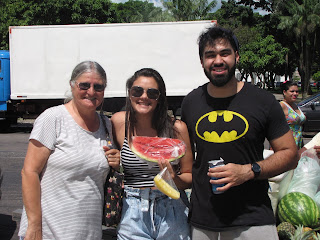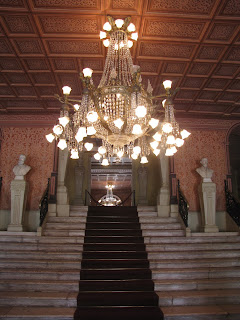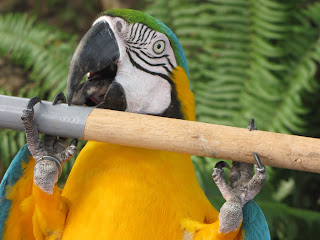Even though we do not have a working SIM card in our phone we were able to order a Uber taxi using just the internet from our guest house. It is so much chr eaper than a metered city taxi and you can get an estimate of the price before you start your journey. You pay using a credit card that is registered to your name so you don't need to worry about not having enough cash or leaving a tip.
The Recife airport was well organised and very modern. We had booked a flight with Azul Airlines to Belem rather than go by by night buses over the huge stretch of the coast to get there.
At the airport was this cabin hotel where you could have a bed in the sleep box. It had a vending machine where you organised payment and booking. We were not sure how quiet it would be as the airport announced all flights over the sound system.
The airline provided a non-alcohol drink and packets of biscuits or crackers during the flight. Some people got a packet of all the choices and then rang the bell for more, noticeably the obese man next to us who was at the end of his extension seat belt as it was. John enjoyed watching some soccer games on the sport channels and I managed to find a documentary on high diving in Mexico and one on a young Bali surfer with commentaries in English. Most adults around us liked the Cartoon Network channel. It was a comfortable two and a half hour flight with the last hour in driving rain.
Belem was a hot muggy 32 DegC when we arrived at our pousada. It was really lovely with an outdoor eating area for breakfast and a well laid out garden with humming birds hovering around the flowers creeping over a wire frame that provided welcomed shade. The staff were great and keen to help with whatever we needed. We were able to catch up with BBC and CNN news and John could watch more sport on our room TV. Usually the TVs do not have any English speaking channels.
We were located near a huge three storey mall and ate there in the evening at the food court. Most of the fast food franchises had hamburgers on the menu and we were thankful for the stir fry vegetables from the Chinese chain.
Our first task in Belem was to book a passage for the Amazon river boat journey from Belem to Santarem. Once that was done we headed off to see the sights. Some of the sights of Belem were the largest open air market in Latin America called Ver O Peso, The name came from the way goods were traded as the locals had no currency and needed to see the goods before deciding what to trade.
The clock tower
The Portuguese fort was built in 1622 to protect the river mouth. Belem profited from the rubber industry but that collapsed in 1914. It was kept afloat by the Brazil nut and the timber industry.
While looking around the old port and fort area we were approached by a young Brazilian guy and his friend. We told him we needed to buy a hammock for the boat trip so he pointed us to the right shop and negotiated a 10% discount for us. We chatted about a lot of things and he told us he studied marine engineering. He took us to our pousada and offered to take us to try some local dishes the next evening.
We passed a museum and went in where there was a small exhibition of the festivals that are held in the city.It was another place where we got in for free. There were no signs in English so Italo translated for us and shared how he participated in the festivals.It was very interesting and well laid out but poorly attended.
We visited the Theatro da Paz. It was built in the Neoclassical style with money made by the rubber barons. Much of the interior was brought from Europe. As we are idosos (old aged) we got to do a tour for free. Some of the tiny mosaic tiles were glued with some kind of fish product. The timber ceilings were hand painted. Under the seats on the second floor were vents. Ice was placed under on the floor below to create a cooling air flow under the seats. While the tour was led by a young girl in Portuguese a friend of hers accompanied her and translated her talk to English for us. She was studying English and wanted to be an English teacher so we helped her out with some vocabulary and expressions so she was grateful to learn something new.
This is the original layout of the seating.
The tiers were for the different classes and those on the top tier had to stand to see the performance.
Some concerts are free and we missed the Wednesday session. They have operas, the philharmonic orchestra and the Amazonia Jazz band play here.
Italo and his girlfriend Carol picked us up one afternoon and took us to a park that had a few animals and birds.
The park also had a small naval museum and once again we were admitted free because of our ages.
A macaw being helped back to a tree by a worker.
The slow moving iguana were all over the place.
The egrets didn't want to leave the area and were everywhere.
Ibis.
Later that evening Italo and Carol took us to a local restaurant to try out some local river shrimps, and indigenous dishes. At 9 o'clock he asked if we wanted to go home or go somewhere else. He then took us to the Docas cultural centre. It is a dock area where the warehouses have been converted into restaurants and bars. Musicians entertained diners from a platform above the room. Indigenous arts and crafts were for sale in small shops along the perimeter and the place was buzzing with families who could afford the high prices. The cruise ships stop here too. He ordered a snack of a metre long sausage stuffed with cheese that we nibbled through along with some craft beers. It was a nice place to sit outside with a bit of the river breeze to cool us.
On our final morning Italo and Carol picked us up at the pousada and dropped us at the wharf where we boarded our boat at 8am for a 12pm sailing. We were most impressed with them both for spending time with a couple of idosos and telling us so much about their town and their lives and their future plans. We doubt that any 24 year old NZ'ers would have done what they did for us and we appreciate their time and interest in us and our lives.
Brazil is full of surprises.
Next stop The Amazon.
The Recife airport was well organised and very modern. We had booked a flight with Azul Airlines to Belem rather than go by by night buses over the huge stretch of the coast to get there.
At the airport was this cabin hotel where you could have a bed in the sleep box. It had a vending machine where you organised payment and booking. We were not sure how quiet it would be as the airport announced all flights over the sound system.
The airline provided a non-alcohol drink and packets of biscuits or crackers during the flight. Some people got a packet of all the choices and then rang the bell for more, noticeably the obese man next to us who was at the end of his extension seat belt as it was. John enjoyed watching some soccer games on the sport channels and I managed to find a documentary on high diving in Mexico and one on a young Bali surfer with commentaries in English. Most adults around us liked the Cartoon Network channel. It was a comfortable two and a half hour flight with the last hour in driving rain.
Belem was a hot muggy 32 DegC when we arrived at our pousada. It was really lovely with an outdoor eating area for breakfast and a well laid out garden with humming birds hovering around the flowers creeping over a wire frame that provided welcomed shade. The staff were great and keen to help with whatever we needed. We were able to catch up with BBC and CNN news and John could watch more sport on our room TV. Usually the TVs do not have any English speaking channels.
We were located near a huge three storey mall and ate there in the evening at the food court. Most of the fast food franchises had hamburgers on the menu and we were thankful for the stir fry vegetables from the Chinese chain.
Our first task in Belem was to book a passage for the Amazon river boat journey from Belem to Santarem. Once that was done we headed off to see the sights. Some of the sights of Belem were the largest open air market in Latin America called Ver O Peso, The name came from the way goods were traded as the locals had no currency and needed to see the goods before deciding what to trade.
The clock tower
The Portuguese fort was built in 1622 to protect the river mouth. Belem profited from the rubber industry but that collapsed in 1914. It was kept afloat by the Brazil nut and the timber industry.
While looking around the old port and fort area we were approached by a young Brazilian guy and his friend. We told him we needed to buy a hammock for the boat trip so he pointed us to the right shop and negotiated a 10% discount for us. We chatted about a lot of things and he told us he studied marine engineering. He took us to our pousada and offered to take us to try some local dishes the next evening.
We passed a museum and went in where there was a small exhibition of the festivals that are held in the city.It was another place where we got in for free. There were no signs in English so Italo translated for us and shared how he participated in the festivals.It was very interesting and well laid out but poorly attended.
We visited the Theatro da Paz. It was built in the Neoclassical style with money made by the rubber barons. Much of the interior was brought from Europe. As we are idosos (old aged) we got to do a tour for free. Some of the tiny mosaic tiles were glued with some kind of fish product. The timber ceilings were hand painted. Under the seats on the second floor were vents. Ice was placed under on the floor below to create a cooling air flow under the seats. While the tour was led by a young girl in Portuguese a friend of hers accompanied her and translated her talk to English for us. She was studying English and wanted to be an English teacher so we helped her out with some vocabulary and expressions so she was grateful to learn something new.
This is the original layout of the seating.
The tiers were for the different classes and those on the top tier had to stand to see the performance.
Some concerts are free and we missed the Wednesday session. They have operas, the philharmonic orchestra and the Amazonia Jazz band play here.
Italo and his girlfriend Carol picked us up one afternoon and took us to a park that had a few animals and birds.
The park also had a small naval museum and once again we were admitted free because of our ages.
A macaw being helped back to a tree by a worker.
The slow moving iguana were all over the place.
The egrets didn't want to leave the area and were everywhere.
Ibis.
Later that evening Italo and Carol took us to a local restaurant to try out some local river shrimps, and indigenous dishes. At 9 o'clock he asked if we wanted to go home or go somewhere else. He then took us to the Docas cultural centre. It is a dock area where the warehouses have been converted into restaurants and bars. Musicians entertained diners from a platform above the room. Indigenous arts and crafts were for sale in small shops along the perimeter and the place was buzzing with families who could afford the high prices. The cruise ships stop here too. He ordered a snack of a metre long sausage stuffed with cheese that we nibbled through along with some craft beers. It was a nice place to sit outside with a bit of the river breeze to cool us.
On our final morning Italo and Carol picked us up at the pousada and dropped us at the wharf where we boarded our boat at 8am for a 12pm sailing. We were most impressed with them both for spending time with a couple of idosos and telling us so much about their town and their lives and their future plans. We doubt that any 24 year old NZ'ers would have done what they did for us and we appreciate their time and interest in us and our lives.
Brazil is full of surprises.
Next stop The Amazon.


















No comments:
Post a Comment